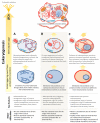Open Questions on the Origin of Eukaryotes
- PMID: 26455774
- PMCID: PMC4640172
- DOI: 10.1016/j.tree.2015.09.005
Open Questions on the Origin of Eukaryotes
Abstract
Despite recent progress, the origin of the eukaryotic cell remains enigmatic. It is now known that the last eukaryotic common ancestor was complex and that endosymbiosis played a crucial role in eukaryogenesis at least via the acquisition of the alphaproteobacterial ancestor of mitochondria. However, the nature of the mitochondrial host is controversial, although the recent discovery of an archaeal lineage phylogenetically close to eukaryotes reinforces models proposing archaea-derived hosts. We argue that, in addition to improved phylogenomic analyses with more comprehensive taxon sampling to pinpoint the closest prokaryotic relatives of eukaryotes, determining plausible mechanisms and selective forces at the origin of key eukaryotic features, such as the nucleus or the bacterial-like eukaryotic membrane system, is essential to constrain existing models.
Keywords: archaea; eukaryogenesis; membrane; metabolism; origin of nucleus; symbiosis; syntrophy.
Copyright © 2015 Elsevier Ltd. All rights reserved.
Figures


References
-
- Lane N, Martin W. The energetics of genome complexity. Nature. 2010;467:929–934. - PubMed
-
- Timmis JN, et al. Endosymbiotic gene transfer: organelle genomes forge eukaryotic chromosomes. Nat Rev Genet. 2004;5:123–135. - PubMed
-
- Embley TM, Martin W. Eukaryotic evolution, changes and challenges. Nature. 2006;440:623–630. - PubMed
Publication types
MeSH terms
Grants and funding
LinkOut - more resources
Full Text Sources
Other Literature Sources

